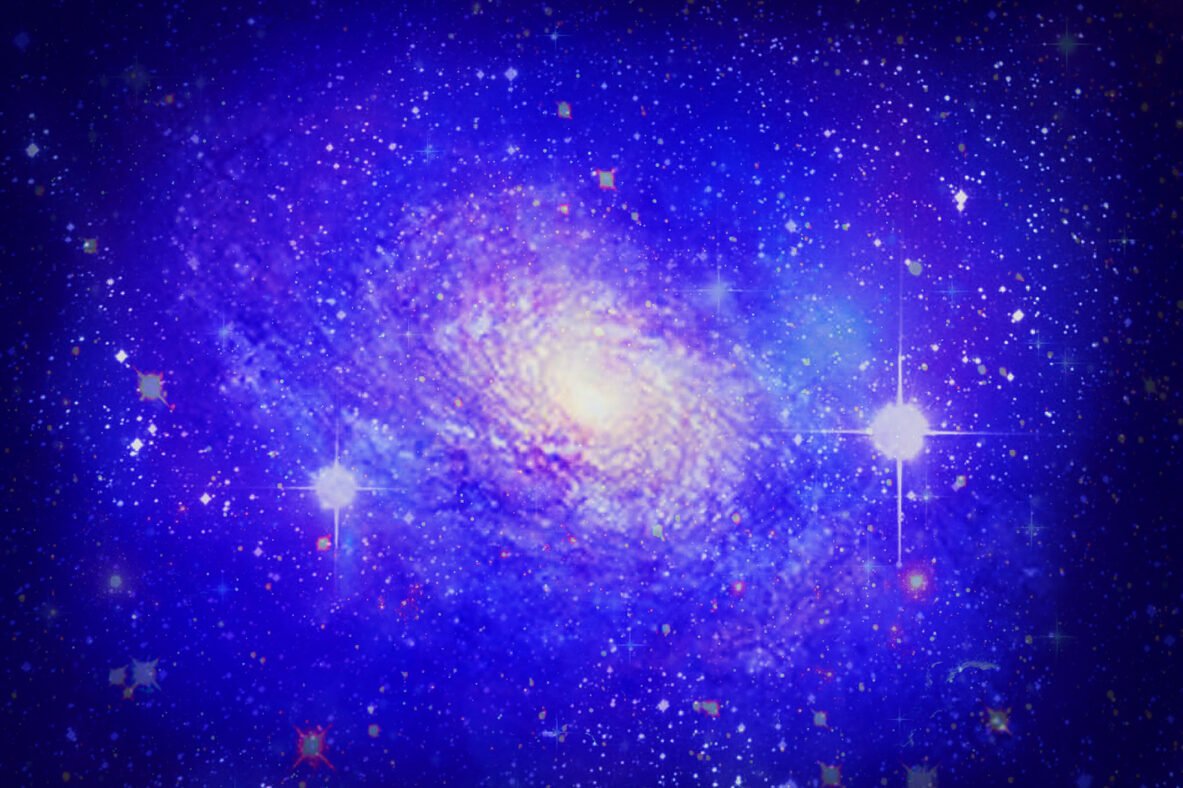Galaxies Weren’t Supposed to Exist Without Dark Matter

For decades, dark matter has been the invisible glue holding our understanding of the universe together. Galaxies spin faster than they should, stars remain bound that ought to drift apart, and entire cosmic structures rely on this unseen substance for stability. So when astronomers discovered a galaxy that appeared to have none of it, the finding hit like a cosmic earthquake.
The galaxy, known as DF2, doesn’t behave like it’s supposed to. Its stars move in ways that can be entirely explained by visible matter — something that’s never been observed in a galaxy of this size. This goes against everything cosmologists believed about how galaxies form and stay intact. If galaxies can exist without dark matter, then maybe we’ve been overestimating its role — or worse, misunderstanding it completely. Either way, this isn’t just a weird outlier. It’s a red flag waving in the face of physics as we know it.
The Galaxy Is Surprisingly Transparent
One of the first things astronomers noticed about DF2 was how oddly transparent it is. Unlike most galaxies, which look like thick swirls of stars and gas, DF2 appears faint and diffuse, like a ghost floating in space. This unusual clarity actually helped scientists measure the motion of its stars more precisely — and what they found didn’t match expectations.
Typically, stars in galaxies move as if they’re being influenced by a much larger, invisible mass — what we call dark matter. But in DF2, the stars weren’t moving fast enough to require anything beyond the visible mass. It was like pulling back the curtain and seeing only what was physically there, no hidden forces, no mysterious halo. That eerie transparency didn’t just make the galaxy beautiful. It made it revolutionary — a silent challenger to one of astrophysics’ most foundational assumptions.
DF2 Wasn’t a One-Off — There Are More Like It
At first, scientists thought DF2 might be a freak accident. Maybe it formed under rare conditions, or maybe the data was skewed. But then another galaxy, DF4, showed up with similarly puzzling traits — also missing dark matter, also confusing scientists. The idea that this was just a fluke began to fade.
If multiple galaxies can form and exist without the gravitational support of dark matter, then the question becomes: how? Are there certain cosmic environments where dark matter is pushed out or never arrives? Or are we misunderstanding how galaxies form entirely? The discovery of more than one dark matter-free galaxy suggests a pattern that can’t be ignored. It pushes researchers to dig deeper, reexamine their models, and explore whether other forces or overlooked variables could be shaping the cosmos in ways we’ve missed.
It’s Making Scientists Question Their Models of Galaxy Formation
Galaxies are thought to begin with massive clumps of dark matter, which then attract gas and dust to form stars. Without that dark matter “skeleton,” the structure shouldn’t hold together. But DF2 is flipping that story. It seems to have formed and remained stable without any detectable dark matter — meaning our entire sequence of galactic formation may need rewriting.
This forces astrophysicists to confront an uncomfortable possibility: maybe dark matter isn’t the foundation of structure, but just one way the universe builds. Perhaps there are alternative methods for forming galaxies — or maybe dark matter behaves differently under certain circumstances. It’s a shift from certainty to curiosity, from rigid theory to open-ended questions. And that kind of upheaval, while unsettling, is also the fuel of scientific progress.
Modified Gravity Theories Are Back in the Spotlight
For years, a small group of scientists have proposed that maybe dark matter doesn’t exist at all and that the laws of gravity themselves might need tweaking at cosmic scales. These “modified gravity” theories were once pushed to the fringe, overshadowed by the prevailing dark matter model. But with discoveries like DF2, they’re starting to make a quiet comeback.
If galaxies can behave normally without dark matter, maybe it’s not missing mass — maybe it’s a misunderstanding of how mass behaves. The discovery of DF2 doesn’t prove these alternative theories, but it gives them a reason to be reconsidered. At the very least, it shows that the standard model has holes that need patching. Whether it leads to a new force, a refined equation, or a brand-new theory altogether, DF2 has done something rare in science that made people look twice at the thing they thought they already understood.
The Discovery Was Double-Checked with Multiple Telescopes
When DF2 was first announced, the backlash was immediate. Some researchers doubted the measurements or suggested the distance to the galaxy had been miscalculated. If DF2 was closer than originally estimated, its apparent lack of dark matter could have been a mistake in perception. The team behind the discovery took this seriously and went back to the drawing board.
They used multiple telescopes, including the Hubble Space Telescope and the Keck Observatory, to remeasure its distance and velocity with different methods. The result? DF2 really was where they thought it was — and still lacked the expected gravitational signature of dark matter. This kind of rigorous validation is what gives the finding so much weight. It wasn’t just a quirk of data or a one-time observation. It was a confirmed anomaly, observed from different angles, using the best tools science has to offer.
It’s Forcing Scientists to Redefine What a Galaxy Even Is

Galaxies have always been defined by a set of features: stars, gas, dust, and an invisible halo of dark matter holding everything together. But if you remove that last part — and the galaxy still holds together — then what are you left with? Is it still a galaxy, or something else entirely?
This discovery isn’t just about tweaking equations. It’s about rethinking the very categories scientists use to describe the universe. DF2 and DF4 challenge the notion that dark matter is a defining ingredient in galaxy formation. They force scientists to expand the definition, or create a new classification altogether. That redefinition could ripple through everything from how we categorize satellite galaxies to how we simulate the growth of the cosmic web. It’s not just the structure of galaxies that’s at stake — it’s the structure of astrophysics itself.
It Hints That Dark Matter Might Be Less Uniform Than We Thought
Until recently, dark matter was assumed to be everywhere — evenly distributed in the halos around galaxies. But DF2 challenges that assumption. If some galaxies have none, or much less than expected, then dark matter might not be as uniform or universal as scientists thought.
That opens the door to new theories. Perhaps dark matter clumps more erratically, or maybe it can be stripped away under certain cosmic conditions. Maybe galaxy collisions, black hole jets, or even quantum-scale interactions can separate dark matter from baryonic matter in ways we’ve never witnessed before. Whatever the explanation, it implies that the invisible skeleton of the universe might be a lot more chaotic — and a lot more interesting — than previously believed.
It’s Triggering a Hunt for More Anomalies
Once DF2 made headlines, astronomers began combing through data from telescope surveys and archives, hunting for more galaxies that might lack dark matter. If even a small number of them exist, it could represent a whole new class of galactic objects — one we’ve overlooked simply because we weren’t looking for it.
The result is a new wave of research aimed at finding dark matter–deficient galaxies in various environments, from dense galaxy clusters to lonely outskirts of the cosmic map. New instruments like the James Webb Space Telescope and next-generation ground telescopes may play a critical role in this search. Every new anomaly adds weight to the idea that the standard model needs expanding. And each dark matter–free galaxy that’s confirmed pushes us closer to a more complete — and more complex — picture of how the universe works.
The Implications Reach Beyond Galaxies
The stakes of this discovery aren’t limited to galaxies. Dark matter is a key part of the standard cosmological model. It influences everything from the rate of cosmic expansion to the behavior of galaxy clusters to the distribution of cosmic microwave background radiation. If our understanding of dark matter is flawed, the implications cascade across all of astrophysics.
The detection of a galaxy without dark matter doesn’t automatically break the model, but it cracks it — and scientists are now forced to account for exceptions. Are our measurements off? Is there another force at play? Could dark matter decay, hide, or behave differently in unusual environments? These are the kinds of questions that could take years to answer, but they’re already changing how scientists write simulations, interpret cosmic maps, and teach students about the architecture of the universe.
It’s a Reminder That the Universe Still Keeps Secrets
For all our satellites, telescopes, and simulations, the universe still manages to surprise us. Just when scientists begin to feel confident in their theories, along comes something like DF2 — a cosmic oddball that refuses to follow the rules. This isn’t failure. It’s science working exactly as it should: probing, testing, and revising our understanding of reality.
The fact that we can be shaken by a single ghostly galaxy is a powerful reminder of how little we truly know. And that’s not discouraging — it’s thrilling. Discoveries like this reignite the curiosity that drives science forward. They tell us that even in a sky full of stars, there are still mysteries waiting in the spaces between. And sometimes, those mysteries rewrite everything.
We May Be on the Edge of a Scientific Revolution

Scientific revolutions don’t happen overnight. They build slowly, through years of questioning, doubting, testing, and reworking old ideas. DF2 may be the first spark in what could become a much larger paradigm shift. If future discoveries continue to challenge the role of dark matter — or even suggest that another force entirely is shaping the cosmos — then we could be on the verge of one of the biggest shifts in physics since Einstein’s time.
What starts as a quiet observation in a telescope often becomes the foundation of a new way of seeing the universe. Whether that means redefining dark matter, rewriting the laws of gravity, or uncovering a new class of galactic formation, DF2 has already done something extraordinary: it made the cosmos feel strange again. And in science, strange is always a good sign.
